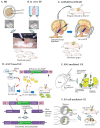Recent Advances in the Production of Genome-Edited Rats
- PMID: 35269691
- PMCID: PMC8910656
- DOI: 10.3390/ijms23052548
Recent Advances in the Production of Genome-Edited Rats
Abstract
The rat is an important animal model for understanding gene function and developing human disease models. Knocking out a gene function in rats was difficult until recently, when a series of genome editing (GE) technologies, including zinc-finger nucleases (ZFNs), transcription activator-like effector nucleases (TALENs), and the type II bacterial clustered regularly interspaced short palindromic repeats (CRISPR)/CRISPR-associated Cas9 (CRISPR/Cas9) systems were successfully applied for gene modification (as exemplified by gene-specific knockout and knock-in) in the endogenous target genes of various organisms including rats. Owing to its simple application for gene modification and its ease of use, the CRISPR/Cas9 system is now commonly used worldwide. The most important aspect of this process is the selection of the method used to deliver GE components to rat embryos. In earlier stages, the microinjection (MI) of GE components into the cytoplasm and/or nuclei of a zygote was frequently employed. However, this method is associated with the use of an expensive manipulator system, the skills required to operate it, and the egg transfer (ET) of MI-treated embryos to recipient females for further development. In vitro electroporation (EP) of zygotes is next recognized as a simple and rapid method to introduce GE components to produce GE animals. Furthermore, in vitro transduction of rat embryos with adeno-associated viruses is potentially effective for obtaining GE rats. However, these two approaches also require ET. The use of gene-engineered embryonic stem cells or spermatogonial stem cells appears to be of interest to obtain GE rats; however, the procedure itself is difficult and laborious. Genome-editing via oviductal nucleic acids delivery (GONAD) (or improved GONAD (i-GONAD)) is a novel method allowing for the in situ production of GE zygotes existing within the oviductal lumen. This can be performed by the simple intraoviductal injection of GE components and subsequent in vivo EP toward the injected oviducts and does not require ET. In this review, we describe the development of various approaches for producing GE rats together with an assessment of their technical advantages and limitations, and present new GE-related technologies and current achievements using those rats in relation to human diseases.
Keywords: CRISPR/Cas9; GONAD/i-GONAD; TALENs; ZFNs; adeno-associated virus; electroporation; embryonic stem cell; genome editing; microinjection; rats.
Conflict of interest statement
The founding sponsors had no role in the design of the study, the collection, analyses, or interpretation of data, the writing of the manuscript, or the decision to publish the results.
Figures




Similar articles
-
Improved Genome Editing via Oviductal Nucleic Acids Delivery (i-GONAD): Protocol Steps and Additional Notes.Methods Mol Biol. 2023;2631:325-340. doi: 10.1007/978-1-0716-2990-1_14. Methods Mol Biol. 2023. PMID: 36995675
-
Genome Editing of Rat.Methods Mol Biol. 2023;2637:223-231. doi: 10.1007/978-1-0716-3016-7_17. Methods Mol Biol. 2023. PMID: 36773150
-
Successful i-GONAD in Mice at Early Zygote Stage through In Vivo Electroporation Three Min after Intraoviductal Instillation of CRISPR-Ribonucleoprotein.Int J Mol Sci. 2022 Sep 14;23(18):10678. doi: 10.3390/ijms231810678. Int J Mol Sci. 2022. PMID: 36142589 Free PMC article.
-
i-GONAD: A method for generating genome-edited animals without ex vivo handling of embryos.Dev Growth Differ. 2019 Jun;61(5):306-315. doi: 10.1111/dgd.12620. Epub 2019 Jun 14. Dev Growth Differ. 2019. PMID: 31198998 Review.
-
Recent Advances and Future Perspectives of In Vivo Targeted Delivery of Genome-Editing Reagents to Germ Cells, Embryos, and Fetuses in Mice.Cells. 2020 Mar 26;9(4):799. doi: 10.3390/cells9040799. Cells. 2020. PMID: 32225003 Free PMC article. Review.
Cited by
-
A Standardized Rat Model to Study Peri-implantitis of Transmucosal Osseointegrated Implants.Biomater Res. 2024 Jun 1;28:0021. doi: 10.34133/bmr.0021. eCollection 2024. Biomater Res. 2024. PMID: 38828365 Free PMC article.
-
Efficient CRISPR/Cas9-mediated knockin of reporter genes in rats at ROSA26 by pronuclear microinjection.Dev Growth Differ. 2025 May;67(4):215-225. doi: 10.1111/dgd.70007. Epub 2025 Apr 23. Dev Growth Differ. 2025. PMID: 40269535 Free PMC article.
-
The history, use, and challenges of therapeutic somatic cell and germline gene editing.Fertil Steril. 2023 Sep;120(3 Pt 1):528-538. doi: 10.1016/j.fertnstert.2023.02.040. Epub 2023 Mar 5. Fertil Steril. 2023. PMID: 36878350 Free PMC article. Review.
-
Rare disease research resources at the Rat Genome Database.Genetics. 2023 Aug 9;224(4):iyad078. doi: 10.1093/genetics/iyad078. Genetics. 2023. PMID: 37119810 Free PMC article.
-
Genetic Modifications to Alter Blood Pressure Level.Biomedicines. 2022 Aug 1;10(8):1855. doi: 10.3390/biomedicines10081855. Biomedicines. 2022. PMID: 36009402 Free PMC article. Review.
References
-
- Vetter R., Rehfeld U., Reissfelder C., Weifl W., Wagner K.D., Günther J., Hammes A., Tschöpe C., Dillmann W., Paul M. Transgenic overexpression of the sarcoplasmic reticulum Ca2+ ATPase improves reticular Ca2+ handling in normal and diabetic rat hearts. FASEB J. 2002;16:1657–1659. doi: 10.1096/fj.01-1019fje. - DOI - PubMed
Publication types
MeSH terms
Substances
Grants and funding
LinkOut - more resources
Full Text Sources

